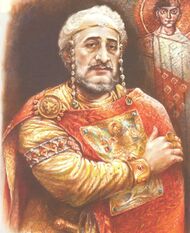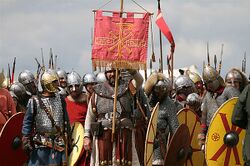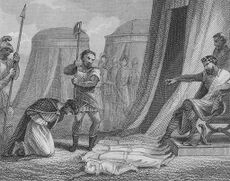Maurice

“Some people call me Maurice, 'cause I speak of the pompatus of love.”
Maurice (Latin: Flavius Mauricius Tiberius; 12 December 539 – 27 November 602) was the Byzantine Emperor from 582 to 602. His rule is a gigantic tragicomedy, in which victory after victory kept them laughing, but everyone dies in the end.
Early life[edit]
Maurice was born in 539 in Cappadocia. His pudgy sister, Gordita, married the general Philippicus and worked the Fry-o-lator at Taco Belli. Maurice spoke Greek, unlike many previous emperors, or at least most who knew him said his utterances "were Greek to me."
Maurice reached Constantinople as the Notary Public to the Excubitors, in service to Tiberius II. When Tiberius got his official title in 574, Maurice was named comes excubitorum, which is surely not as naughty as it sounds.
Persian War[edit]
In 577, Maurice was put in command of the entire eastern front of the Byzantine army, despite a complete and utter lack of military experience — an asset that had done predecessor Justinian no good at all. The next year, a truce in Mesopotamia came to an end, so it was time for war to resume. Sassanid Persia struck the first blow, but Maurice attacked on both sides of the Tigris River, surrounding and subduing all its waterfalls. Not only did he sack Singara, he de-throned the Piano Playera.
Emperor Khosrow sued for peace in 579, but before negotiations could conclude, he made the tactical mistake of dying. His successor Hormizd IV declared that it was "time for us to move in a new direction," namely, back to more fighting. However, the next year, Persia decided it needed another Khosrow (Khosrow II). He convinced many rebels to stop rebelling.
In 581, Maurice took his army to capture Ctesiphon, the Persian capital. However, a key bridge was "out" and the supply line was too. Maurice had to retreat, and the only thing he showed signs of winning was a campaign of finger-pointing and excuse-making involving allied commander al-Mundhir III of the Ghassanid Arabs, the same swarthy people that, 1400 years later, people would visit to "Ghass up."
Maurice charged "Al" with spilling the beans to the Persians, enabling them to destroy that important bridge. Historian John of Emphysema calls this a lie, as when you march a huge army toward a bridge across the Euphrates, it is patently obvious to everyone that you intend to cross it. When both commanders wrote letters to Tiberius, he merely replied that they should "try to get along." It was another thing altogether when Maurice went to Constantinople in person; Tiberius charged al-Mundhir with treason. This had two important effects: al-Mundhir got arrested, and the Byzantines got a new enemy to fight, the Ghassanids.
Advance to the throne[edit]
In 582, Tiberius was struck down by an illness. In his delirium, he named two heirs — Maurice and Germanus — and simultaneously married off both his daughters Constantina and Charito. Maurice got Constantina. The plan was to divide the Byzantine Empire in two, with Maurice getting the eastern provinces. Tiberius had written a fine speech but was now too weak to give it. The Chief Justice read it for him; it went, "Maurice gets everything, lock, stock, and barrel!" Maurice and Constantina got married and lived happily ever after, given that the Empire was bankrupt, at war with Persia, getting its Balkan provinces chewed up by the Slavs, and on the hook for 80,000 gold pieces a year to keep the Avars from opening up yet another front. As for Germanus and Charito, they conveniently disappeared from the public records and went back to nature in the Thracian hills. Perhaps.
Maurice said, "First things first!" and continued fighting the Persians. Actually, "first thing" should have been to pay his troops. They mutinied in 588, but took time out from their mutiny to repulse an opportunistic Persian attack. Later in the year, they captured Martyropolis and made the Persian commander a Martyr. The Byzantines got a lot of loot and sent it back to Maurice in Constantinople, along with the head of the defeated commander as a paperweight.
Palace intrigue broke out in Persia. King Hormizd was overthrown and Khosrow II took the throne. But Bahram Chobin insisted he had not started the coup so as not to become king, and Khosrow and his faction fled to Constantinople. Though the Senate was unanimously opposed, Maurice sent 35,000 Byzantines to get Khosrow his country back. They succeeded in 591. Maurice adopted Khosrow, received Western Armenia in return, and even tried to convert Khosrow to Christianity, about which, You can't have everything. But you can have the millions you used to pay Persia every year not to attack you.
Balkan wars[edit]
The Avars, the Slavs, and their Huns had been chewing up Carpathia and Dalmatia for years, ever since the money ran out to pay them not to. However, calming the eastern frontier left Maurice free to deal with them. The victories came in rapid succession, not counting the defeats:
- 592: Retook Belgrade
- 593–594: Crossed the Danube and won in Wallachia
- 595: Got a peace treaty with the Avars that looked a lot like their surrender
- 599–601: The Byzantines wreaked havoc with virtually everyone
Maurice began making plans to repopulate the Balkans by having Armenians dress up as Byzantines.
Domestic policy[edit]
Maurice set up provinces in Italy and Africa. Roman administration had always separated civilian and military offices, but Maurice lumped them both together, and gave his provincial governors (the exarches) autonomy from Constantinople. In all, there were exactly as many thrones as Maurice had sons.
The only cloud on the horizon was his tendency, from necessity, to do everything "on the cheap." In addition to the 25% military pay cut, which led to the mutiny mentioned above, there was the time he refused to pay the Avars ransom so they would free 12,000 Byzantine soldiers. The Avars killed their prisoners, and when a military delegation arrived in Constantinople to protest, led by Phocas, Maurice's fateful response was simply, "Phoc you too."
Death[edit]
Phocas got the last laugh. In 602, Maurice ordered his troops to spend the winter beyond the Danube and to keep attacking. The weary troops proclaimed Phocas their leader and started the "Anybody but Maurice" movement. Riots broke out in Constantinople. Phocas entered the city in November and was crowned emperor. Maurice and his sons were murdered. Worse still, his wife and daughters were sent to a monastery. Maurice's vision of five seats of power, each headed by one of his sons, was never implemented, as his sons no longer had heads.
At this point, all Hell broke loose. In Persia, King Khosrow II saw that his patron was gone and renewed the war against the Byzantines. This war would weaken both empires, let the Slavs settle the Balkans, and let the Arabs do what Arabs do. English historian A.H.M. Jones calls Maurice's death the end of Classical Antiquity and the start of Early Modern Shit-storm. C.W. Previté-Orton says Maurice made "right and wise" decisions, which everyone in Byzantium hated. "He was a better judge of policy than of men," he writes. Indeed, it was not policy who beheaded him.
| Preceded by: Tiberius II |
Byzantine Emperor 582–602 |
Succeeded by: Phocas |





